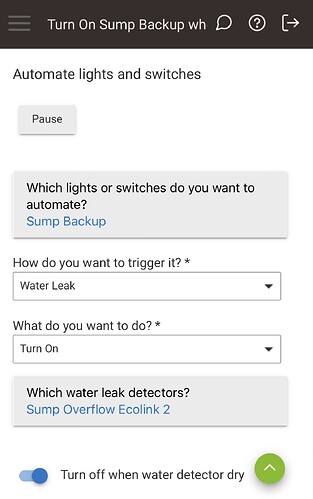My primary/dumb/mechanical sump pump failed and I’ve got my backup in place. It doesn’t have a float so I’m using an Ecolink Flood+Freeze sensor that hangs at an appropriate depth into my sump to trigger an Aeotec outlet (with energy monitoring) that powers the backup pump. I want to use SAR to automate this, which seems simple, but when testing I found that the rule would activate them milliseconds later it would turn off, despite the leak sensor showing what seems to be a consistent “wet” the whole time.
I wonder what I can do to fix this? Maybe debouce “turn on for at least 30sec, or until all sensors show dry”?
Sidebar: the UI isn’t clear about the behavior if you select multiple leak sensors. Presumably the rule uses an OR between them to activate, eh?
If your backup sump pump does not have a float switch, you can always add one such as this if it is normal 110V.
https://www.homedepot.com/p/Superior-Pump-Wide-Angle-Tethered-Float-Switch-92000/302330583
The problem with your scenario is that a sump pump generates a lot of heat. It is made to be submersed in water for cooling purposes. If the pump runs dry, the pump will overheat and you are likely to burn out the motor.
I have a primary sump pump and an auxiliary pump that only runs when there is heavy water runoff. It has operated the past week due to melting of the snow pack around our house. I have it plugged into a Zen15 Z-wave switch which never turns off. When the pump starts, the switch sends a power alert to Hubitat which then triggers an announcement on my chime/sirens that the backup sump pump is running. However, that pump has its own float switch to shut the pump off as soon as the water level drops in the sump. The float switch is a mechanical/electrical device which is far less prone to malfunction than electronic devices, some of which might be battery powered.
I mean... I sorta have a float switch using my original idea of a water sensor and a smart plug... if I could just make it work, lol.
Yes, I appreciate you calling out the heat issues and I've actually got another pump on order that's basically a higher flow version of my same thing, plus a built in float switch (supposed to have arrived today, looks like tomorrow now). Very cool to see they sell "dumb" switches like this at Home Depot, which is something I might pick up next time I'm there on principle!
I prefer the sump pumps that have integrated float switches. However, the nice thing about the standalone switches is that they can easily be replaced.
A couple of weeks ago, my leak sensor triggered an alarm at 3:00 am when my water softener went into recharge mode and the sump pump did not pump the water out. Fortunately, I have an automatic valve on the main water supply, so the water was turned off immediately. No more than a cupful of water spilled on the floor.
When I pulled out the sump pump, I found that the integrated level switch would work if the water level increased slowly, but once the water level reached a certain level, the pump would stop. Because the water softener had added water to the sump so quickly, the level went too high and the pump turned off. OOPS! With this pump, I think there is a reed switch inside a tube and a magnet in the float triggers the switch. The magnet got too far above the reed switch to start the pump. Unfortunately, since this was an integrated switch, the switch could not be repaired. I had to replace the entire sump pump rather than just the switch. The pump was nearly 10 years old, so it was time to get a new one anyway.
If you purchase one of the standalone float switches, be sure to clamp it to the discharge pipe of the pump with only a few inches of slack. You want the float to move up and down, but if you have too much slack, the level might get to high before the pump starts. You also have to be careful that the float does not hand up on anything in the sump. I had roots grow in my auxilary sump and entangle the standalone float. I now have a pump with an integrated float switch.


